The Western (Wailing) Wall and the Holy Esplanade
PeriBlog VIII: Jerusalem, Israel
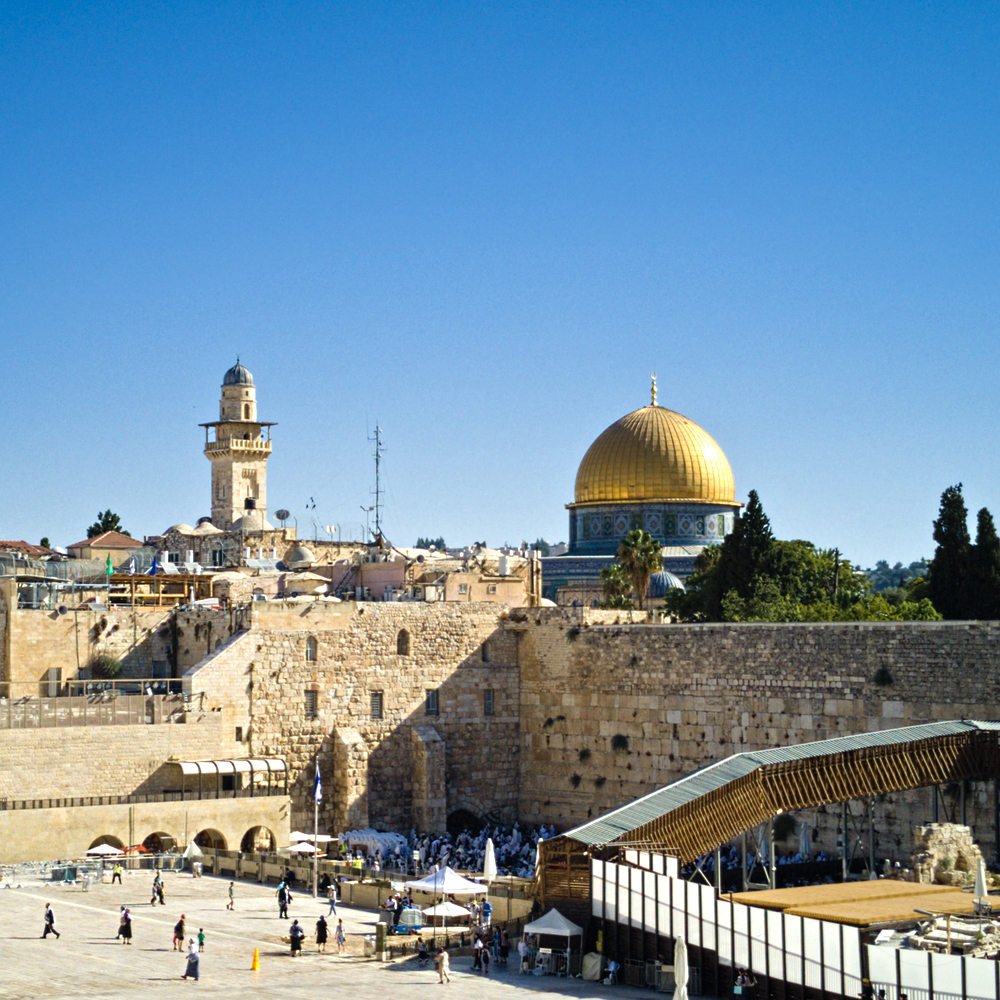
The Dome of the Rock atop the Holy Esplanade
At the center of Jerusalem’s Old City stands the most hotly-contested piece of real estate on the planet: the Western Wall and the Holy Esplanade.
This is arguably the most important site in Judaism. It also played a significant role in early Christian history, and it is said to be the place where Mohammed prayed before his ascent to heaven.
The site is steeped in controversy. Even the name is disputed. For the Jews, it is known as Har haBayit (Temple Mount). Muslims name it al-Haram al-Shariff (Noble Sanctuary). Neither side agrees on a name, and a writer must be careful here: referring to the site as Temple Mount implies support for Israel’s claim of ownership; naming it al-Haram al-Shariff endorses the view that this is Islamic property.
The United Nations suggests that writers and journalists thread the needle by adopting a third moniker: the “Holy Esplanade.” This term appears to have no historical foundation. As with most attempts at political correctness, it trips at the first hurdle of colloquial usage: you won’t hear this name in the mouths of locals, nor will you find signs in the Old City directing you to the Holy Esplanade.
Welcome to Jerusalem.
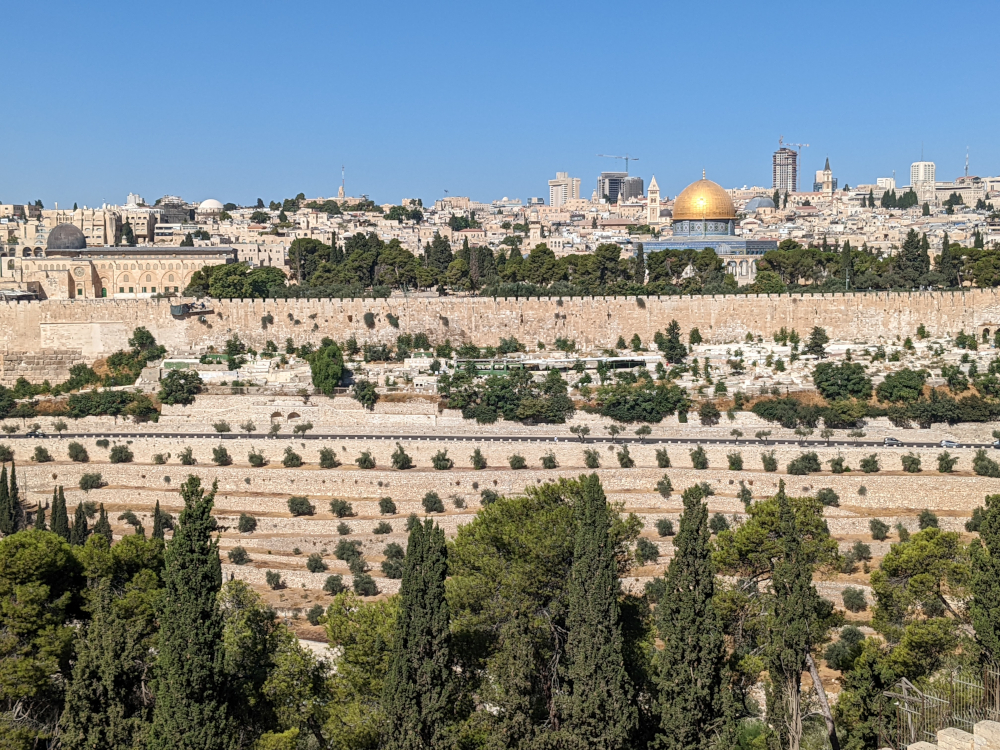
The Dome of the Rock, as seen from the Mount of Olives
Fortunately, I am an ancient historian, not a diplomat. I don’t have to offer a solution that will resolve the Israeli/Palestinian impasse, nor do I need to offer an opinion about which name is more appropriate.
Holy Esplanade it is.
If the traditions are true, the site has been the scene of many famous events. This was where Abraham proved his faith by nearly sacrificing Isaac (Gen 22:1-19). It is believed that King David built an altar here (2 Sam 24:18:25) and his son, Solomon, replaced that with the first Jewish temple in the tenth century BC. That structure endured until the Neo-Babylonians sacked Jerusalem and destroyed the temple in 587 BC—“Tear it down,” they cried, “Tear it down to its foundations.” (Ps 137:7).
The temple was rebuilt under Persian rule and, although not very impressive, it served as the center of Jewish worship until the reign of King Herod the Great. Around 20 BC, the king decided to refurbish and expand the temple. Herod’s engineers built a large stone box around the the hill, and back-filled it with rubble to create an elevated, flat surface. This raised platform (the Holy Esplanade) supported an enlarged and renovated temple; by the time of Christ, it was a showpiece for Israel’s religion. It was here that Jesus preached and expelled the moneylenders.
Near the end of the First Jewish Revolt (AD 66-70), the Roman army sacked Jerusalem and destroyed most of the temple. In the aftermath of the Second Jewish Revolt (AD 132-135), Emperor Hadrian erased the last signs of Judaism from the site, renamed the city Aelia Capitolina, and built a temple honoring Jupiter on the spot.
Herod’s retaining walls were all that remained after the Romans finished their work. Today Israel’s Jewish community offers prayers at the exposed Western (or Wailing) Wall.
As noted above, this complex is a significant flash point between the two religions. Security is tight. Armed Israeli soldiers man each gate, and one must pass through metal detectors before entering. As we approached the wall, Mary and I were separated—women to the right, and I, after donning a white tourist’s yarmulke, was shuttled to the left, the men’s section.
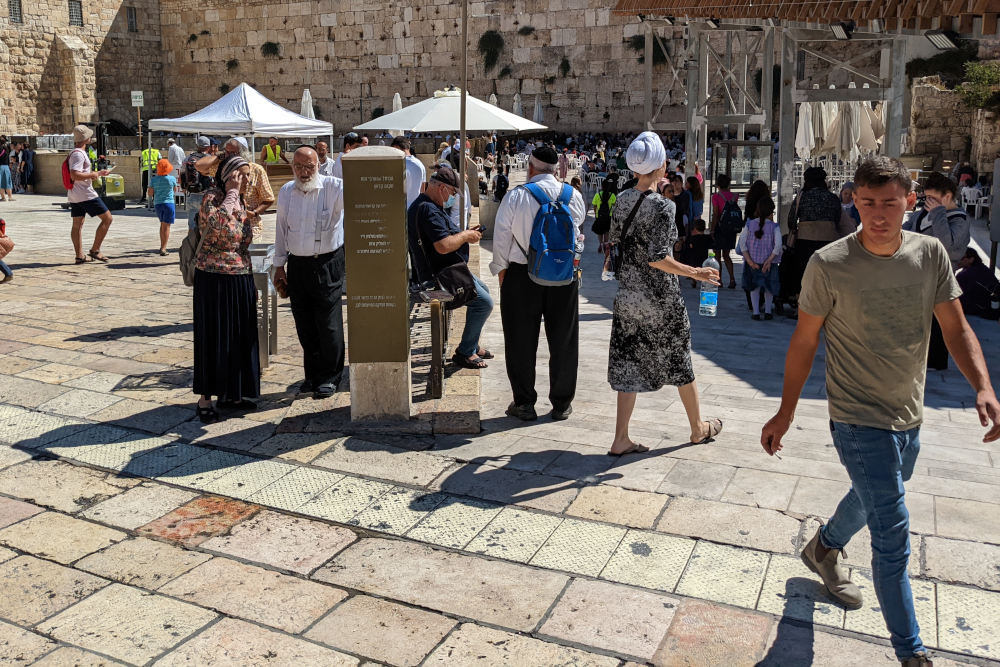
Women to the right, men to the left
Hundreds of Orthodox Jews, dressed in heavy black suits and black Italian fedoras, stood before the wall. They prayed and chanted psalms, bouncing on their toes with spiritual energy.
When finished, the worshipers walk backwards as they move away from the wall. It is considered bad form to turn your back on this place.
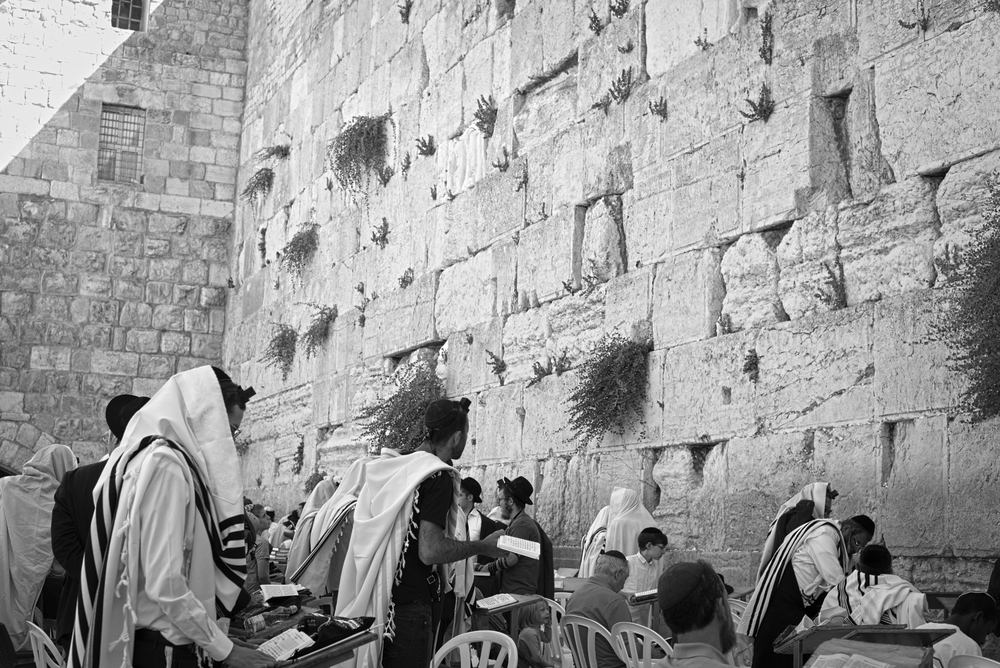
Praying before the Western Wall
The Jews believe that God’s presence continues to linger in these stones, and this is the closest that they are allowed to come to the Foundation Stone. Once the center of the temple, the Foundation Stone is the rock upon which the Ark of the Covenant once stood. Many assert that the Foundation Stone is the center of the world, the first fruit of God’s act of creation.
After centuries of neglect, the Holy Esplanade re-entered religious history with the birth of Islam. According to the 17th chapter of the Koran, a miraculous steed named Buraq carried Mohammed to the “Farthest Mosque” where he prayed with the prophets before making an ascent to heaven. Scholars later identified Jerusalem’s Holy Esplanade as the site of the “Farthest Mosque.” The claim that Mohammed once stood atop these walls secured the esteem of the Prophet’s followers: the Holy Esplanade is the third most important (after Mecca and Medina) place in Islam.
In the seventh century, after Islamic forces conquered Jerusalem, two new mosques—al Aqsa and the Dome of the Rock—were built. The Dome of the Rock stands over the Foundation Stone. Beneath the stone is the Well of Souls. It is said that the voices of those souls awaiting judgment can be heard whispering in the well. These two mosques, albeit renovated many times, still crown the Holy Esplanade and are two of the oldest mosques in the world.
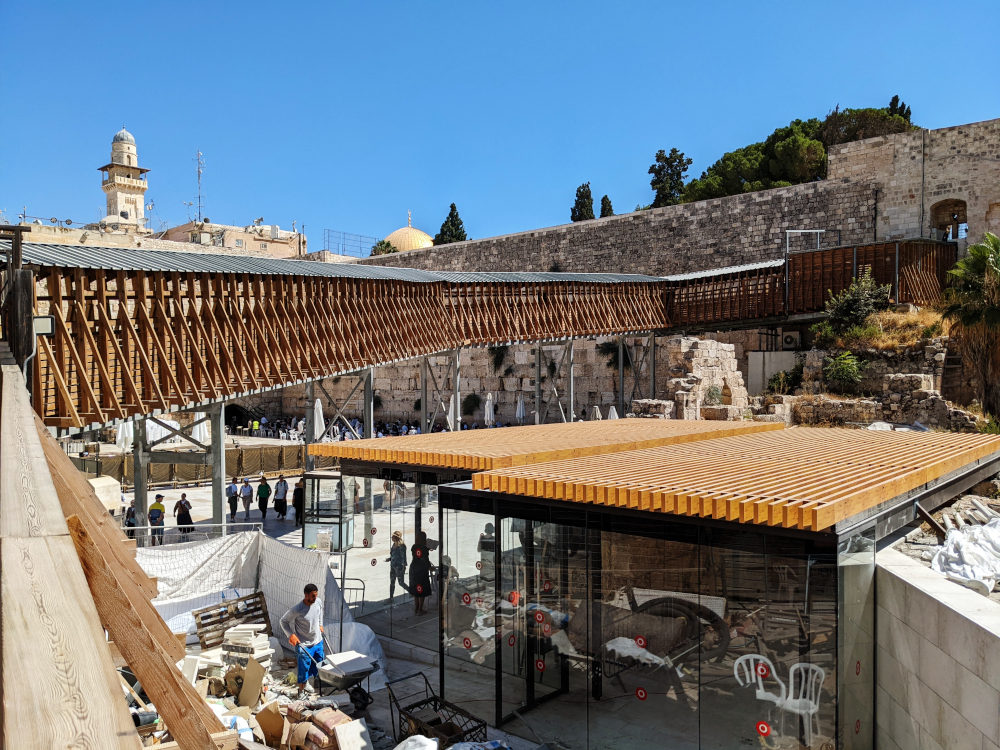
Wooden ramp to the Mughrabi Gate
Access to the great plaza atop the Holy Esplanade is strictly controlled. Non-muslims must enter through the Mughrabi (Moroccan) Gate. Information on visiting hours is difficult to find. It took two days before I hit the right time (around 10:15 a.m.). I passed the security checkpoint and ascended the wooden ramp that rises to the top of the Holy Esplanade. At the top, a young woman walking behind me was turned back—the guards considered her bare shoulders and a knee-displaying skirt inappropriate.
I passed beneath the Moroccan Gate into a large piazza, filled with the broken remains of marble columns. Here I made a crucial mistake. I noticed the large museum labeled “Islamic Museum.” In the moment, it seemed an excellent place to begin my tour—a logical place to learn about the site.
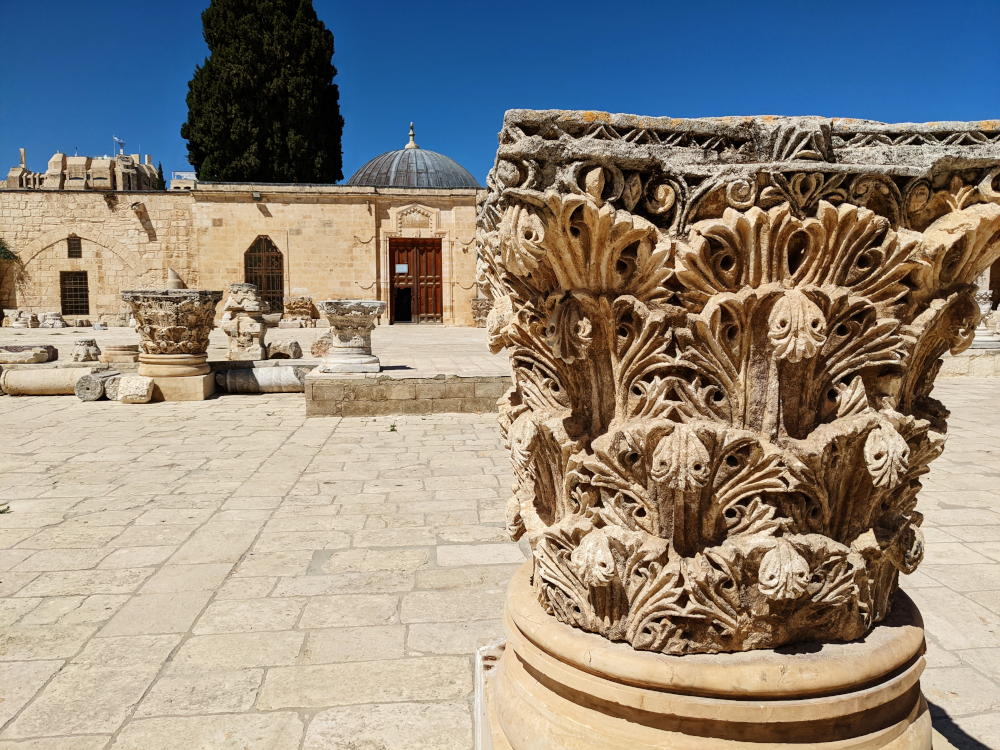
Broken column, with Islamic Museum in the background
I entered the museum—which charges no admission fee—and spent the next thirty minutes happily admiring Islamic antiquities. I studied the examples of Islamic art, the calligraphy inked on the page of massive Korans, and ornate doors saved from ruined mosques. I lingered over examples of ancient Islamic coins, rifles, and swords. It was a delightful museum, and I enjoyed my visit.
Unfortunately I failed to realize that a clock was ticking.
After exiting the museum, I crossed the plaza to the entrance of the al-Aqsa mosque. I knew that I couldn’t enter, but I wanted to stand for a moment and take it all in. As I lingered, trying to catch a glimpse of the interior, one of the guards stalked over.
“Time for visiting is over,” he said. “You must leave.” He pointed to the nearest gate.
Expelled, like Adam, from Paradise.
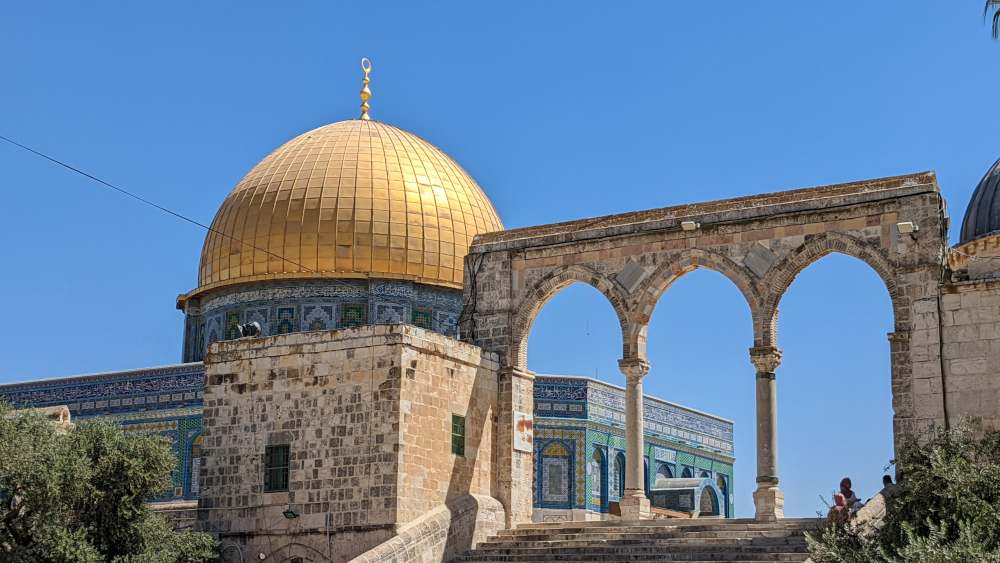
A quick shot of the Dome of the Rock as I am expelled
I walked sadly toward the Cotton Merchant’s Gate, turning aside only for a moment to snap a photo of the Dome of the Rock.
It is unfortunate that this place, so integral to two great religions, is marred by violence and political discord. I don’t want to sound like a Pollyanna, but it certainly would be wonderful if we could drag representatives of all factions to a bargaining table and find a way to share this common heritage.
Meanwhile, I will find better information about the visiting hours, and, when the weather cools, return for an extended visit.
If you are enjoying this series, why not subscribe to Richard's monthly newsletter, What's New in Old News? The Peripatetic Historian is on the road, roaming the world and compiling fresh adventures. Don't miss out. Click here to join the legions of above-average readers who have already subscribed.